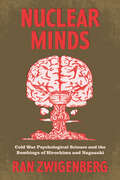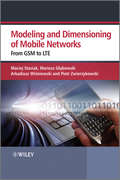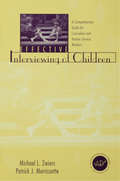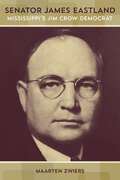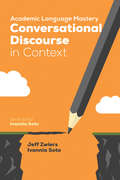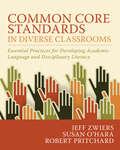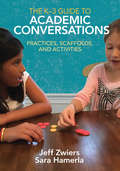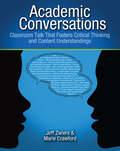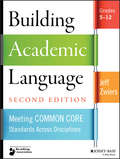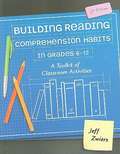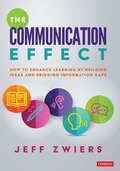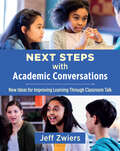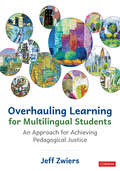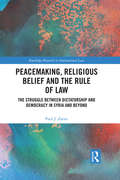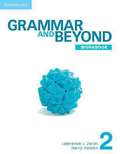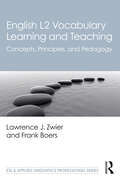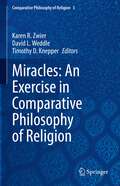- Table View
- List View
Hiroshima
by Ran ZwigenbergIn 1962, a Hiroshima peace delegation and an Auschwitz survivor's organization exchanged relics and testimonies, including the bones and ashes of Auschwitz victims. This symbolic encounter, in which the dead were literally conscripted in the service of the politics of the living, serves as a cornerstone of this volume, capturing how memory was utilized to rebuild and redefine a shattered world. This is a powerful study of the contentious history of remembrance and the commemoration of the atomic bomb in Hiroshima in the context of the global development of Holocaust and World War II memory. Emphasizing the importance of nuclear issues in the 1950s and 1960s, Zwigenberg traces the rise of global commemoration culture through the reconstruction of Hiroshima as a 'City of Bright Peace', memorials and museums, global tourism, developments in psychiatry, and the emergence of the figure of the survivor-witness and its consequences for global memory practices.
Nuclear Minds: Cold War Psychological Science and the Bombings of Hiroshima and Nagasaki
by Ran ZwigenbergHow researchers understood the atomic bomb’s effects on the human psyche before the recognition of Post-Traumatic Stress Disorder. In 1945, researchers on a mission to Hiroshima with the United States Strategic Bombing Survey canvassed survivors of the nuclear attack. This marked the beginning of global efforts—by psychiatrists, psychologists, and other social scientists—to tackle the complex ways in which human minds were affected by the advent of the nuclear age. A trans-Pacific research network emerged that produced massive amounts of data about the dropping of the bomb and subsequent nuclear tests in and around the Pacific rim. Ran Zwigenberg traces these efforts and the ways they were interpreted differently across communities of researchers and victims. He explores how the bomb’s psychological impact on survivors was understood before we had the concept of post-traumatic stress disorder. In fact, psychological and psychiatric research on Hiroshima and Nagasaki rarely referred to trauma or similar categories. Instead, institutional and political constraints—most notably the psychological sciences’ entanglement with Cold War science—led researchers to concentrate on short-term damage and somatic reactions or even, in some cases, on denial of victims’ suffering. As a result, very few doctors tried to ameliorate suffering. But, Zwigenberg argues, it was not only that doctors “failed” to issue the right diagnosis; the victims’ experiences also did not necessarily conform to our contemporary expectations. As he shows, the category of trauma should not be used uncritically in a non-Western context. Consequently, this book sets out, first, to understand the historical, cultural, and scientific constraints in which researchers and victims were acting and, second, to explore how suffering was understood in different cultural contexts before PTSD was a category of analysis.
Festivals of the World: Poland
by Aldona M. Zwierzynska-ColdicottExperience all the color and excitement of a Polish swieta in this intriguing volume. Learn about namedays, see the Passion Play in Kalwaria Zebrzydowska, then make a Palm Sunday palm and have your own swieta! This exciting series of informational books introduces young readers to the festivals and cultures of some of the most fascinating countries in the world. Each volume is written in a lively style accompanied by striking photographs that encourage further study of our worldwide neighborhood. Easy, step-by-step instructions for creating a craft and preparing a food item add to the fun and provide the basics for a do-it-yourself festival.
Modelling and Dimensioning of Mobile Wireless Networks
by Piotr Zwierzykowski Arkadiusz Wisniewski Mariusz Glabowski Maciej StasiakThis book is a must-read for all network planners and other professionals wishing to improve the quality and cost efficiency of 3G and LTE networksIn this book, the authors address the architecture of the 2/3G network and the Long Term Evolution (LTE) network. The book proposes analytical models that make the analysis and dimensioning of the most important interfaces, i.e. WCDMA or Iub, possible. Furthermore, the authors include descriptions of fundamental technological issues in 2/3 G networks, basic traffic engineering models and frequent examples of the application of analytical models in the analysis and dimensioning of the interface of cellular networks. The specific knowledge included in the content will enable the reader to understand and then to prepare appropriate programming softwares that will allow them to evaluate quality parameters of cellular networks, i.e. blocking probabilities or call losses. Additionally, the book presents models for the analysis and dimensioning of the Wideband Code Division Multiple Access (WCDMA) radio interface and the Iub interface, both carrying a mixture of Release 99 traffic (R99) and High-Speed Packet Access (HSPA) traffic streams. Finally, the analytical models presented in the book can be also used in the process of modeling and optimization of LTE networks.Key Features:Describes the architecture and the modes of operation of the cellular 2/3/4G systems and the LTE network Covers the traffic theory and engineering within the context of mobile networks Presents original analytical methods that enable their users to dimension selected interfaces of cellular networks Discusses models for the analysis and dimensioning of the Wideband Code Division Multiple Access (WCDMA) radio interface and the Iub interface, both carrying a mixture of Release 99 traffic (R99) and High-Speed Packet Access (HSPA) traffic streams Includes problems as well as an accompanying website containing solutions, software tools and interactive flash animations (http://wiley.teletraffic.pl) This book will be an invaluable guide for professional engineers (radio planning engineers, optimization engineers, transmission engineers, core network engineers, Service Management engineers) working in the areas of mobile wireless networks technology, not only in optimization process, but also in profitability assessment of newly implemented services (i.e. in NPV - Net Present Value analysis), and researchers and scientists. Advanced students in the fields of mobile communications networks and systems will also find this book insightful.
Effective Interviewing of Children: A Comprehensive Guide for Counselors and Human Service Workers
by Michael Zwiers Patrick J. MorrissetteFirst published in 1999. Routledge is an imprint of Taylor & Francis, an informa company.
Senator James Eastland: Mississippi's Jim Crow Democrat (Making the Modern South)
by Maarten ZwiersIn the years following World War II, the national Democratic Party aligned its agenda more and more with the goals of the civil rights movement. By contrast, a majority of southern Democrats remained as committed as ever to a traditional, segregationist ideology. Through the career of Senator James Eastland, one of the mid-century's most prominent politicians, author Maarten Zwiers explores the uneasy, yet mutually beneficial relationship between conservative southerners and the increasingly liberal party to which they belonged. Mississippi Democrat James "Big Jim" Eastland began an influential four-decade career in the United States Senate in 1941, ultimately rising to become president pro tempore of the Senate, a position that placed him third in the line of presidential succession. His reputation for toughness developed from his unfailing and ruthless opposition to greater civil rights and his concern over the global spread of communism, as he believed participants in the two movements were working together to undermine the American way of life. Zwiers contends that despite Eastland's extreme positions, he still managed to maintain influence through productive relationships with his Senate colleagues-liberal as well as conservative. Though the progressive wing of the Democratic Party continued to push for stronger civil rights legislation, they valued compromise with southern senators like Eastland in order to ensure support from a region the Democrats could ill afford to lose. While Eastland's campaigning rhetoric was inflammatory, his ability to operate within the national political structure by leveraging moderate concessions contributed to his lengthy and effective career. Drawing on recently opened archival records, Maarten Zwiers offers a nuanced portrait of a man frequently portrayed as a southern zealot. Senator James Eastland provides a case study of the complicated relationship between party and party members that allowed Democrats to maintain power in the South for much of the twentieth century.
Academic Language Mastery: Conversational Discourse in Context
by Jeff Zwiers Ivannia M. SotoBy now it’s a given: if we’re to help our ELLs and SELs access the rigorous demands of today’s content standards, we must cultivate the “code” that drives school success: academic language. Look no further for assistance than this much-anticipated series from Ivannia Soto, in which she invites field authorities Jeff Zwiers, David and Yvonne Freeman, Margarita Calderon, and Noma LeMoine to share every teacher’s need-to-know strategies on the four essential components of academic language. The subject of this volume is conversational discourse. Here, Jeff Zwiers reveals the power of academic conversation in helping students develop language, clarify concepts, comprehend complex texts, and fortify thinking and relational skills. With this book as your roadmap, you’ll learn how to: Foster the skills and language students must develop for productive interactions Implement strategies for scaffolding paired conversations Assess student’s oral language development as you go It’s imperative that our ELLs and SELs practice academic language in rich conversations with others in school, especially when our classrooms may be their only opportunities to receive modeling, scaffolding, and feedback focused on effective discourse. This book, in concert with the other three volumes in the series, can provide both a foundation and a framework for accelerating the learning of diverse students across grade levels and disciplines.
Academic Language Mastery: Conversational Discourse in Context
by Jeff Zwiers Ivannia M. SotoBy now it’s a given: if we’re to help our ELLs and SELs access the rigorous demands of today’s content standards, we must cultivate the “code” that drives school success: academic language. Look no further for assistance than this much-anticipated series from Ivannia Soto, in which she invites field authorities Jeff Zwiers, David and Yvonne Freeman, Margarita Calderon, and Noma LeMoine to share every teacher’s need-to-know strategies on the four essential components of academic language. The subject of this volume is conversational discourse. Here, Jeff Zwiers reveals the power of academic conversation in helping students develop language, clarify concepts, comprehend complex texts, and fortify thinking and relational skills. With this book as your roadmap, you’ll learn how to: Foster the skills and language students must develop for productive interactions Implement strategies for scaffolding paired conversations Assess student’s oral language development as you go It’s imperative that our ELLs and SELs practice academic language in rich conversations with others in school, especially when our classrooms may be their only opportunities to receive modeling, scaffolding, and feedback focused on effective discourse. This book, in concert with the other three volumes in the series, can provide both a foundation and a framework for accelerating the learning of diverse students across grade levels and disciplines.
Common Core Standards in Diverse Classrooms: Essential Practices for Developing Academic Language and Disciplinary Literacy
by Jeff Zwiers Susan O'Hara Robert PritchardThe Common Core State Standards require students to do more with knowledge and language than ever before. Rather than be mere consumers of knowledge, students must now become creators, critics, and communicators of ideas across disciplines. Yet in order to take on these new and exciting roles, many students need daily teaching with an extra emphasis on accelerating their academic communication skills. Common Core Standards in Diverse Classrooms: Essential Practices for Developing Academic Language and Disciplinary Literacy describes seven research-based teaching practices for developing complex language and literacy skills across grade levels and disciplines: using complex texts, fortifying complex output, fostering academic interaction, clarifying complex language, modeling, guiding, and designing instruction. Most important, you will find clear descriptions and examples of how these essential practices can-;and should-;be woven together in real lessons. The book: Clarifieshow to support the learning of complex language that students need for reaching Common Core and other standardsProvides practical ways to realize the instructional shifts needed with the implementation of new standards in diverse classroomsIncludes frameworks and descriptions on how to develop students' complex language, speaking, and writingHelps maximize strategies and tools for building system-wide capacity for sustained growth in the practicesCommon Core Standards in Diverse Classrooms is a concise guide for helping us improve our practices to strengthen two vital pillars that support student learning: academic language and disciplinary literacy.
The K-3 Guide to Academic Conversations: Practices, Scaffolds, and Activities
by Jeff Zwiers Sara R. Hamerla“For thousands of years people have been using the skills we describe in this book to engage in conversations with others. What isn’t as prevalent, however, is instruction--especially in primary grades—in which we engage students in productive conversations about academic ideas. This book fills that very big need.” --Jeff Zwiers & Sara Hamerla Talk about content mastery . . . Primary teachers, you won’t want to miss this: if you’re looking for a single resource to foster purposeful content discussions and high-quality interpersonal engagement, then put Jeff Zwiers and Sara Hamerla’s K-3 Guide to Academic Conversations at the top of your reading list. Whether your students love to talk or not, all must be equipped with key conversation skills such as active listening, taking turns, posing, clarifying, supporting with examples, and arguing ideas. This ready resource comes packed with every imaginable tool you could need to make academic conversations part of your everyday teaching: Sample lesson plans and anchor charts Guidelines for creating effective prompts Applications across content areas, with corresponding assessments Rubrics and protocols for listening to student speech Transcripts of conversations and questions for reflection Companion website with video and downloadable resources Tens of thousands of students in the upper grades have reaped the benefits of academic conversations: high-quality face-to-face interactions, increased motivation, stronger collaborative argumentation skills, and better understanding and retention of content. The K-3 Guide to Academic Conversations is that resource for providing your primary students with the same powerful learning opportunities.
The K-3 Guide to Academic Conversations: Practices, Scaffolds, and Activities
by Jeff Zwiers Sara R. Hamerla“For thousands of years people have been using the skills we describe in this book to engage in conversations with others. What isn’t as prevalent, however, is instruction--especially in primary grades—in which we engage students in productive conversations about academic ideas. This book fills that very big need.” --Jeff Zwiers & Sara Hamerla Talk about content mastery . . . Primary teachers, you won’t want to miss this: if you’re looking for a single resource to foster purposeful content discussions and high-quality interpersonal engagement, then put Jeff Zwiers and Sara Hamerla’s K-3 Guide to Academic Conversations at the top of your reading list. Whether your students love to talk or not, all must be equipped with key conversation skills such as active listening, taking turns, posing, clarifying, supporting with examples, and arguing ideas. This ready resource comes packed with every imaginable tool you could need to make academic conversations part of your everyday teaching: Sample lesson plans and anchor charts Guidelines for creating effective prompts Applications across content areas, with corresponding assessments Rubrics and protocols for listening to student speech Transcripts of conversations and questions for reflection Companion website with video and downloadable resources Tens of thousands of students in the upper grades have reaped the benefits of academic conversations: high-quality face-to-face interactions, increased motivation, stronger collaborative argumentation skills, and better understanding and retention of content. The K-3 Guide to Academic Conversations is that resource for providing your primary students with the same powerful learning opportunities.
Academic Conversations: Classroom Talk that Fosters Critical Thinking and Content Understandings
by Jeff Zwiers Marie CrawfordConversing with others has given insights to different perspectives, helped build ideas, and solve problems. Academic conversations push students to think and learn in lasting ways. Academic conversations are back-and-forth dialogues in which students focus on a topic and explore it by building, challenging, and negotiating relevant ideas. In Academic Conversations: Classroom Talk that Fosters Critical Thinking and Content Understandings authors Jeff Zwiers and Marie Crawford address the challenges teachers face when trying to bring thoughtful, respectful, and focused conversations into the classroom. They identify five core communications skills needed to help students hold productive academic conversation across content areas: Elaborating and Clarifying Supporting Ideas with Evidence Building On and/or Challenging Ideas Paraphrasing Synthesizing This book shows teachers how to weave the cultivation of academic conversation skills and conversations into current teaching approaches. More specifically, it describes how to use conversations to build the following: Academic vocabulary and grammar Critical thinking skills such as persuasion, interpretation, consideration of multiple perspectives, evaluation, and application Literacy skills such as questioning, predicting, connecting to prior knowledge, and summarizing An academic classroom environment brimming with respect for others' ideas, equity of voice, engagement, and mutual support The ideas in this book stem from many hours of classroom practice, research, and video analysis across grade levels and content areas. Readers will find numerous practical activities for working on each conversation skill, crafting conversation-worthy tasks, and using conversations to teach and assess. Academic Conversations offers an in-depth approach to helping students develop into the future parents, teachers, and leaders who will collaborate to build a better world.
Building Academic Language: Meeting Common Core Standards Across Disciplines, Grades 5-12
by Jeff Zwiers“Of the over one hundred new publications on the Common Core State Standards (CCSS), this one truly stands out! In the second edition of Building Academic Language, Jeff Zwiers presents a much-needed, comprehensive roadmap to cultivating academic language development across all disciplines, this time placing the rigor and challenges of the CCSS front and center. A must-have resource!” —Andrea Honigsfeld, EdD, Molloy College “Language is critical to the development of content learning as students delve more deeply into specific disciplines. When students possess strong academic language, they are better able to critically analyze and synthesize complex ideas and abstract concepts. In this second edition of Building Academic Language, Jeff Zwiers successfully builds the connections between the Common Core State Standards and academic language. This is the ‘go to’ resource for content teachers as they transition to the expectations for college and career readiness.” —Katherine S. McKnight, PhD, National Louis University With the adoption of the Common Core State Standards (CCSS) by most of the United States, students need help developing their understanding and use of language within the academic context. This is crucially important throughout middle school and high school, as the subjects discussed and concepts taught require a firm grasp of language in order to understand the greater complexity of the subject matter. Building Academic Language shows teachers what they can do to help their students grasp language principles and develop the language skills they’ll need to reach their highest levels of academic achievement. The Second Edition of Building Academic Language includes new strategies for addressing specific Common Core standards and also provides answers to the most important questions across various content areas, including: What is academic language and how does it differ by content area? How can language-building activities support content understanding for students? How can teachers assist students in using language more effectively, especially in the academic context? How can academic language usage be modeled routinely in the classroom? How can lesson planning and assessment support academic language development? An essential resource for teaching all students, this book explains what every teacher needs to know about language for supporting reading, writing, and academic learning.
Building Reading Comprehension Habits in Grades 6-12: A Toolkit of Classroom Activities (Second Edition)
by Jeff ZwiersThis second edition succinctly describes practical ideas, including more than 15 new activities, which have been working in a wide range of middle school and high school classrooms. The author has used the ideas, seen them used by others, and researched their effectiveness in a variety of settings.
The Communication Effect: How to Enhance Learning by Building Ideas and Bridging Information Gaps
by Jeff ZwiersThe &“communication effect&” is what happens when we saturate our classrooms with authentic communication, which occurs when students use language to build up ideas and do meaningful things. For starters, authentic communication deepens and increases language development, learning of content concepts and skills, rigor and engagement, empathy and understanding of others&’ perspectives, agency and ownership of core ideas across disciplines, and social and emotional skills for building strong relationships. And these are just the starters. With The Communication Effect, Dr. Jeff Zwiers challenges teachers in Grades 3 and up to focus less on breadth and more on depth by grounding instruction and assessment in authentic (rather than pseudo-) communication. This book provides: Ideas for cultivating classroom cultures in which authentic communication thrives Clear descriptions and examples of the three features of authentic communication: 1. building up key ideas (claims and concepts); 2. clarifying terms and supporting ideas; and 3. creating and filling information gaps Over 175 suggestions for using the three features of authentic communication to enhance twenty commonly used instructional activities across disciplines Additional examples of not-so-commonly-used activities that embody the three features Suggestions for improving four different types of teacher creativity needed to design effective lessons, activities, and assessments that maximize authentic communication Our students deserve to get the most out of each minute of each lesson. Authentic communication can help. As you read The Communication Effect and apply its ideas, you will see how much better equipped and inspired your students are to grow into the amazing and gifted people that they were meant to become.
The Communication Effect: How to Enhance Learning by Building Ideas and Bridging Information Gaps
by Jeff ZwiersThe &“communication effect&” is what happens when we saturate our classrooms with authentic communication, which occurs when students use language to build up ideas and do meaningful things. For starters, authentic communication deepens and increases language development, learning of content concepts and skills, rigor and engagement, empathy and understanding of others&’ perspectives, agency and ownership of core ideas across disciplines, and social and emotional skills for building strong relationships. And these are just the starters. With The Communication Effect, Dr. Jeff Zwiers challenges teachers in Grades 3 and up to focus less on breadth and more on depth by grounding instruction and assessment in authentic (rather than pseudo-) communication. This book provides: Ideas for cultivating classroom cultures in which authentic communication thrives Clear descriptions and examples of the three features of authentic communication: 1. building up key ideas (claims and concepts); 2. clarifying terms and supporting ideas; and 3. creating and filling information gaps Over 175 suggestions for using the three features of authentic communication to enhance twenty commonly used instructional activities across disciplines Additional examples of not-so-commonly-used activities that embody the three features Suggestions for improving four different types of teacher creativity needed to design effective lessons, activities, and assessments that maximize authentic communication Our students deserve to get the most out of each minute of each lesson. Authentic communication can help. As you read The Communication Effect and apply its ideas, you will see how much better equipped and inspired your students are to grow into the amazing and gifted people that they were meant to become.
Next Steps with Academic Conversations: New Ideas for Improving Learning Through Classroom Talk
by Jeff ZwiersDr. Jeff Zwiers, an educational researcher at Stanford University, has spent the last 15 years analyzing classroom conversations to see how they can be better used and improved in classroom settings. Teachers who have worked with him report significant growth in students&’ engagement, content learning, language, creativity, and sense of agency. Zweirs introduced his initial vision for classroom conversations Academic Conversations: Classroom Talk that Fosters Critical Thinking and Content Understanding. His follow-up book, Next Steps with Academic Conversations: New Ideas for Improving Learning Through Classroom Talk , expands the first book with updated classroom strategies and practices. In this new version, teachers will discover: How to introduce buildable ideas and teach students how to develop and support them Equitable classroom discussions and how diverse backgrounds conversing can benefit social skills and emotional intelligence Highlights of new research-based theories on classroom conversation Ways to develop students' confidence in conversation and how classroom skills can apply to real world interactions This resource is the product of his extensive research, co-teaching, and collaborating with a wide range of educators. It was written for busy teachers who want a practical guide for strengthening the quality and quantity of productive conversations in their lessons.
Overhauling Learning for Multilingual Students: An Approach for Achieving Pedagogical Justice
by Jeff ZwiersAdopt a strengths-based, justice-centered approach to teaching multilinguals Offering educators a path to pedagogical justice for multilingual learners, Overhauling Learning for Multilingual Students outlines a comprehensive alternative model for instruction and assessment. With an emphasis on engaging multilingual learners in authentic communication and promoting student agency and creativity, this book is an urgent call-to-action for educators at all levels to value and leverage the many assets that multilingual students bring to every classroom. The book outlines six dimensions of pedagogical justice and offers practical strategies to implement a learner-centered approach that will help all students thrive. Additional features include: An assets-based framework designed to help multilingual learners learn and grow Guidance for shifting instructional strategies away from remediation and test preparation toward an engaging, justice-centered approach Activities to to help students collaboratively build up unique and important ideas (claims and concepts) across disciplines Written by scholar, practitioner, and best-selling author, Jeff Zwiers, Overhauling Learning for Multilingual Students supports educators to de-think and rethink traditional one-size-fits-all approaches to teaching and assessing multilingual learners.
Overhauling Learning for Multilingual Students: An Approach for Achieving Pedagogical Justice
by Jeff ZwiersAdopt a strengths-based, justice-centered approach to teaching multilinguals Offering educators a path to pedagogical justice for multilingual learners, Overhauling Learning for Multilingual Students outlines a comprehensive alternative model for instruction and assessment. With an emphasis on engaging multilingual learners in authentic communication and promoting student agency and creativity, this book is an urgent call-to-action for educators at all levels to value and leverage the many assets that multilingual students bring to every classroom. The book outlines six dimensions of pedagogical justice and offers practical strategies to implement a learner-centered approach that will help all students thrive. Additional features include: An assets-based framework designed to help multilingual learners learn and grow Guidance for shifting instructional strategies away from remediation and test preparation toward an engaging, justice-centered approach Activities to to help students collaboratively build up unique and important ideas (claims and concepts) across disciplines Written by scholar, practitioner, and best-selling author, Jeff Zwiers, Overhauling Learning for Multilingual Students supports educators to de-think and rethink traditional one-size-fits-all approaches to teaching and assessing multilingual learners.
Imperial Unknowns
by Cornel ZwierleinIn this major new study, the history of the French and British trading empires in the early modern Mediterranean is used as a setting to test a new approach to the history of ignorance: how can we understand the very act of ignoring - in political, economic, religious, cultural and scientific communication - as a fundamental trigger that sets knowledge in motion? Zwierlein explores whether the Scientific Revolution between 1650 and 1750 can be understood as just one of what were in fact many simultaneous epistemic movements and considers the role of the European empires in this phenomenon. Deconstructing central categories like the mercantilist 'national', the exchange of 'confessions' between Western and Eastern Christians and the bridging of cultural gaps between European and Ottoman subjects, Zwierlein argues that understanding what was not known by historical agents can be just as important as the history of knowledge itself.
Peacemaking, Religious Belief and the Rule of Law: The Struggle between Dictatorship and Democracy in Syria and Beyond (Routledge Research in International Law)
by Paul J. ZwierThis book offers a new way of understanding the role of the mediator in teaching parties the interrelationship between sustainable peace, forgiveness, and international justice. It argues that the arrival of social media presents new opportunities for reaching sustainable peace agreements, through their use in gathering the detailed information that can match victims and perpetrators of past atrocities. The author aims to advance a more expansive understanding of the subjects and limitations of making peace in the shadow of international law by examining the concepts of mediation and forgiveness that exist alongside law. To that end, the book offers an account of the role of the mediator that emerges from the interplay between Ricouerian imagination and forgiveness and predicts ever-greater opportunities for making peace and protecting human rights that can be facilitated by a harnessing of social media as a tool for making peace with justice. The author also aims to examine how strategies for sustaining the peace must combat the inevitable frustrations with democracy that can lead to a slide into dictatorship. Assad, Obama, and the UN leadership and their decisions concerning making and maintaining peace in Syria are used as case studies to examine the interplay between a leaders’ religious beliefs, faith in democracy and rule of law, and impulses towards totalitarianism.
Principled Negotiation and Mediation in the International Arena
by Paul J. ZwierThis book argues that it can be beneficial for the United States to talk with 'evil' – terrorists and other bad actors – if it engages a mediator who shares the United States' principles yet is pragmatic. It shows how the US can make better foreign policy decisions and demonstrate its integrity for promoting democracy and human rights, by employing a mediator who facilitates disputes between international actors by moving them along a continuum of principles, as political parties act for a country's citizens. This is the first book to integrate theories of rule of law development with conflict resolution methods, and it examines ongoing disputes in the Middle East, North Korea, South America and Africa. It draws on the author's experiences with The Carter Center and judicial and legal advocacy training to provide a sophisticated understanding of the current situation in these countries and of how a strategy of principled pragmatism will give better direction to US foreign policy abroad.
Grammar and Beyond: Level 2 Workbook
by Lawrence J. Zwier Harry HoldenStudents learn real-world language. Grammar and Beyond is based on extensive corpus research into the ways that grammar is used in the real world. The series takes this research base and focuses students' attention on the most relevant and accurate information. Students then immediately apply what they have learned in speaking and writing. While the series places special emphasis on grammar for writing, all four skills are covered thoroughly. As students prepare to write, they practice editing common mistakes-based on an extensive collection of student writing. Then, they apply the grammar directly in a writing task, making a clear connection between what they study and how they write.
English L2 Vocabulary Learning and Teaching: Concepts, Principles, and Pedagogy (ESL & Applied Linguistics Professional Series)
by Lawrence J. Zwier Frank BoersAccessible to experts and non-experts alike, this text is a comprehensive entry to teaching and learning vocabulary in ESL and EFL contexts. Firmly grounded in research, it presents frameworks and methods for teaching vocabulary to English L2 speakers. Overviewing key topics as well as providing in-depth research analyses and critiques, Zwier and Boers address all major areas of vocabulary pedagogy and instruction. Organized in four parts, chapters cover the nature of vocabulary and strands of vocabulary research; curricular approaches; and techniques and activities. Readers are introduced to key topics, including teaching multiword expressions, assessment, discourse, and instruction at different levels. Each chapter includes questions, prompts, and activities to foster discussion. A foundational textbook for courses on L2 instruction and teacher-training courses, it is an essential text for students and scholars in TESOL and Applied Linguistics, and provides the pedagogical grounding future English L2 teachers need to effectively teach vocabulary.
Miracles: An Exercise in Comparative Philosophy of Religion (Comparative Philosophy of Religion #3)
by Karen R. Zwier David L. Weddle Timothy D. KnepperThis volume provides a comparative philosophical investigation into a particular concept from a variety of angles—in this case, the concept of “miracle.” The text covers deeply philosophical questions around the miracle, with a multiplicity of answers. Each chapter brings its own focus to this multifaceted effort. The volume rejects the primarily western focus that typically dominates philosophy of religion and is filled with particular examples of miracle narratives, community responses, and polemical scenarios across widely varying religious contexts and historical periods. Some of these examples defy religious categorization, and some papers challenge the applicability of the concept “miracle,” which is of western and monotheistic origin. By examining miracles thru a wide comparative context, this text presents a range of descriptive content and analysis, with attention to the audience, to the subjective experiences being communicated, and to the flavor of the narratives that come to surround miracles. This book appeals to students and researchers working in philosophy of religion and science, as well those in comparative religion. It represents, in written form, some of the perspectives and dialogue achieved in The Comparison Project’s 2017–2019 lecture series on miracles. The Comparison Project is an enterprise in comparing a variety of religious voices, allowing them to stand in dialogue.

